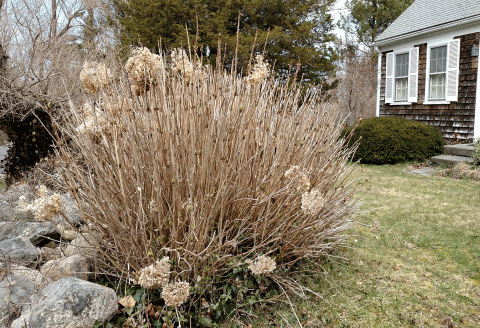Solving the Hydrangea Puzzle

Pruning hydrangeas is a subject that baffles many gardeners - novice and experienced alike. Before you even think about grabbing your pruning tools, you need to identify which species you have in your garden. There are several species of hydrangeas commonly grown in New Hampshire, and all of them have very different growth habits and pruning requirements. While some plants bloom on new growth, others primarily set flower buds on old wood. Follow the brief guide below to determine how and when you should prune your hydrangeas.
Bigleaf hydrangea (Hydrangea macrophylla)
Bigleaf hydrangeas are the quintessential hydrangeas most gardeners are familiar with. Also called mopheads or lacecaps, bigleaf hydrangeas are characterized by shiny, dark green foliage and large colorful blooms. They generally bloom on old wood and can be difficult to get to flower in New Hampshire. Cold winter temperatures and drying winds often kill flower buds, leaving plants with lush foliage but no sign of flowers.
Flower buds are produced at the tips of stems on old wood of the previous year. If those buds are killed or damaged over the winter, the hydrangea’s flowering potential is reduced; although lower buds along the stem have the potential to develop flowers too. Wait to prune your bigleaf hydrangeas until new growth appears in the spring. Make pruning cuts one quarter inch above the first set of live buds. Hint: stems with live buds will be green on the inside, while dead stems will be brown. Entirely dead stems should be cut flush to the base.
If you have trouble getting your bigleaf hydrangea to bloom year after year, consider replacing it with a “remontant” (reblooming) type. A number of cultivars have been released in recent years that flower readily on new shoots.
Mountain Hydrangea (Hydrangea serrata)
Mountain hydrangeas look very similar and are closely related to bigleaf hydrangeas. Mountain hydrangeas have a more delicate branching structure and flowers that are slightly less showy than their relative. Flowers only develop on old wood, so do not remove stems until new growth begins in the spring and you can determine which buds are still viable.
Smooth hydrangea (Hydrangea arborescens)
Smooth hydrangeas are native to Eastern North America and are well suited to most New Hampshire gardens. They have a mounded growth habit and white to pale pink flowers that bloom mid-summer. Unlike bigleaf and mountain hydrangeas, smooth hydrangeas bloom on new wood and will tolerate heavy pruning. Old flowers from the previous year can be removed in late winter through spring. Old stems will flower, but the flowers will be small. For larger, more robust flowers, prune stems to the ground in the spring.
Panicle hydrangea (Hydrangea paniculata)
Undoubtedly the most common hydrangea grown in New Hampshire, panicle hydrangea is incredibly cold hardy and flowers reliably season to season. It grows as an upright, low-branched small tree or large shrub whose branches tend to arch under the weight of numerous, large conical flowers. Panicle hydrangeas bloom on new growth and should be pruned in late winter to early spring before leaf emergence. Remove spent flowers and prune to improve overall plant structure and habit. Make cuts one quarter inch above live buds or to the branch collar of stems.
Oakleaf hydrangea (Hydrangea quercifolia)
Oakleaf hydrangeas are native to the Southeastern part of the United States. Although this shrub may suffer some winter damage and flower bud loss in northern gardens, its striking foliage and exfoliating bark are enough justification to grow it. Oakleaf hydrangeas also bloom on old wood, so only remove dead or damaged branches in the spring. In general, oakleaf hydrangeas do not require much pruning. As needed, thin stems and reduce plant height after new growth has begun.
Many well-meaning gardeners reduce their hydrangea’s blooming potential through simple pruning errors. Fortunately, hydrangeas are really quite simple to care for, as long as you understand their growth habits and follow these simple pruning guidelines.
Got questions? The Ask UNH Extension Infoline offers practical help finding answers for your home, yard, and garden questions. Call toll free at 1-877-398-4769, Monday to Friday, 9 a.m. to 2 p.m., or e-mail us at answers@unh.edu.
